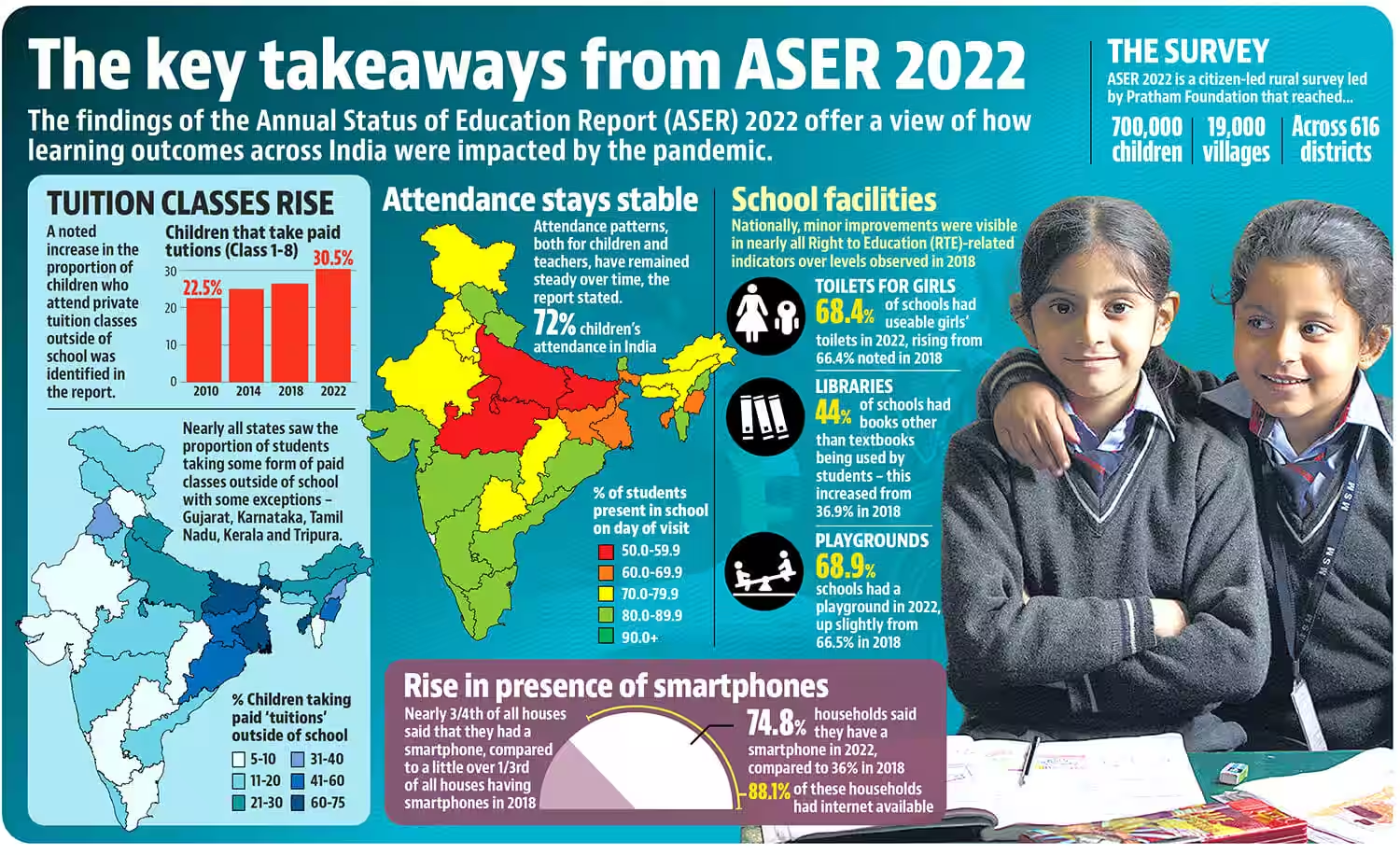Ahmedabad
(Head Office)Address : 506, 3rd EYE THREE (III), Opp. Induben Khakhrawala, Girish Cold Drink Cross Road, CG Road, Navrangpura, Ahmedabad, 380009.
Mobile : 8469231587 / 9586028957
Telephone : 079-40098991
E-mail: dics.upsc@gmail.com

ASER 2022
News: The findings of the first nationwide ASER survey in four years offer significant takeaways.
Background:
• Pratham, a non-governmental organisation (NGO), has been surveying children aged 6 to 14 and publishing ASER since 2005 to track trends in school enrolment, attendance, and reading and arithmetic abilities.
• The current survey covered nearly 7 lakh children across 616 districts. It frames the impact of pandemic on learning outcomes.
Key Findings:
• School enrolment touched a record high (98.4% in 2022, 97.2% in 2018).
• The proportion of girls (aged 11-14) not enrolled has reduced (10.3% in 2006, 4.1% in 2018, 2% in 2022).
• An increase of 7.3 percentage points in government school enrollment in the period 2018 to 2022.
• The report also shows a surge in students attending tuition classes. Between 2018 and 2022, in all states, there is an increase in the proportion of children who attend tuition classes. The exceptions are Gujarat, Karnataka, Tamil Nadu, Kerala and Tripura.
• The percentage of children not going to school has dropped to 2% or below for the first time in 2022.
• As per ASER 2021, 1 in 3 students belonging to classes 1 and 2 did not attend school in person due to reasons such as lack of digital access. But, in according to 2022 report, the availability of smartphones in homes of enrolled students has nearly doubled from 2018 to 2021, from 36.5 per cent to 67.6 per cent.
• However, there has been a drop in learning levels of foundational literacy and numeracy (FLN). For example, in 2022, the basic reading ability of children in Class 3 dipped by 6.8% points from 27.2% in 2018 and the proportion of children in Class 3 who could do at least subtraction fell to 25.9% (from 28.2%).
What can be inferred from ASER 2022?
• The reason why Private tuition went up is probably that it is more flexible. There if flexibility in payment of fees and parents are also seen to be wanting more for their children.
• The enrolment in government schools increased due to factors such as Improvements in infrastructure; distribution of textbooks, midday meals during lockdown; job losses, and the closure of budget private schools in rural areas.
• The government schemes such as NIPUN Bharat and FLN mission have yielded positive results. For example, almost 80 per cent of the schools reported that they had received guidelines and teachers have been trained. This means that the seriousness with which governments are also sort of pushing on NIPUN Bharat is quite high.
Way Forward:
• There is need for integration between the anganwadi system and the school system ibecause the work starts there. There are anganwadis everywhere and their enrollment has gone up.
• The education component of the Anganwadi system must be adequately funded.

Address : 506, 3rd EYE THREE (III), Opp. Induben Khakhrawala, Girish Cold Drink Cross Road, CG Road, Navrangpura, Ahmedabad, 380009.
Mobile : 8469231587 / 9586028957
Telephone : 079-40098991
E-mail: dics.upsc@gmail.com
Address: A-306, The Landmark, Urjanagar-1, Opp. Spicy Street, Kudasan – Por Road, Kudasan, Gandhinagar – 382421
Mobile : 9723832444 / 9723932444
E-mail: dics.gnagar@gmail.com
Address: 2nd Floor, 9 Shivali Society, L&T Circle, opp. Ratri Bazar, Karelibaugh, Vadodara, 390018
Mobile : 9725692037 / 9725692054
E-mail: dics.vadodara@gmail.com
Address: 403, Raj Victoria, Opp. Pal Walkway, Near Galaxy Circle, Pal, Surat-394510
Mobile : 8401031583 / 8401031587
E-mail: dics.surat@gmail.com
Address: 303,305 K 158 Complex Above Magson, Sindhubhavan Road Ahmedabad-380059
Mobile : 9974751177 / 8469231587
E-mail: dicssbr@gmail.com
Address: 57/17, 2nd Floor, Old Rajinder Nagar Market, Bada Bazaar Marg, Delhi-60
Mobile : 9104830862 / 9104830865
E-mail: dics.newdelhi@gmail.com